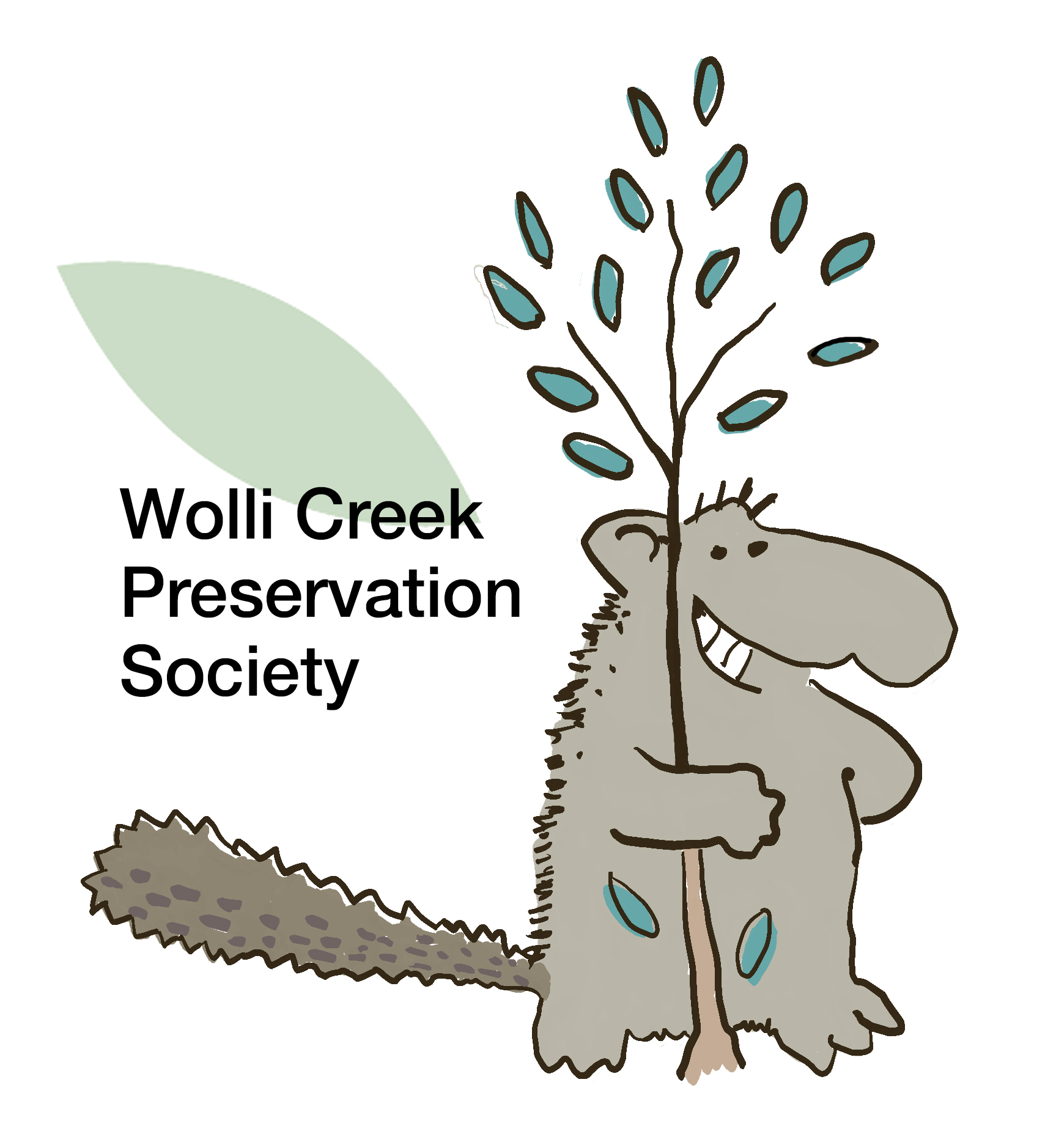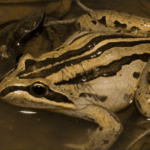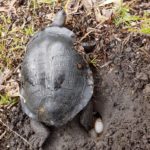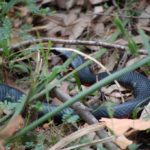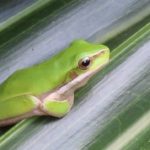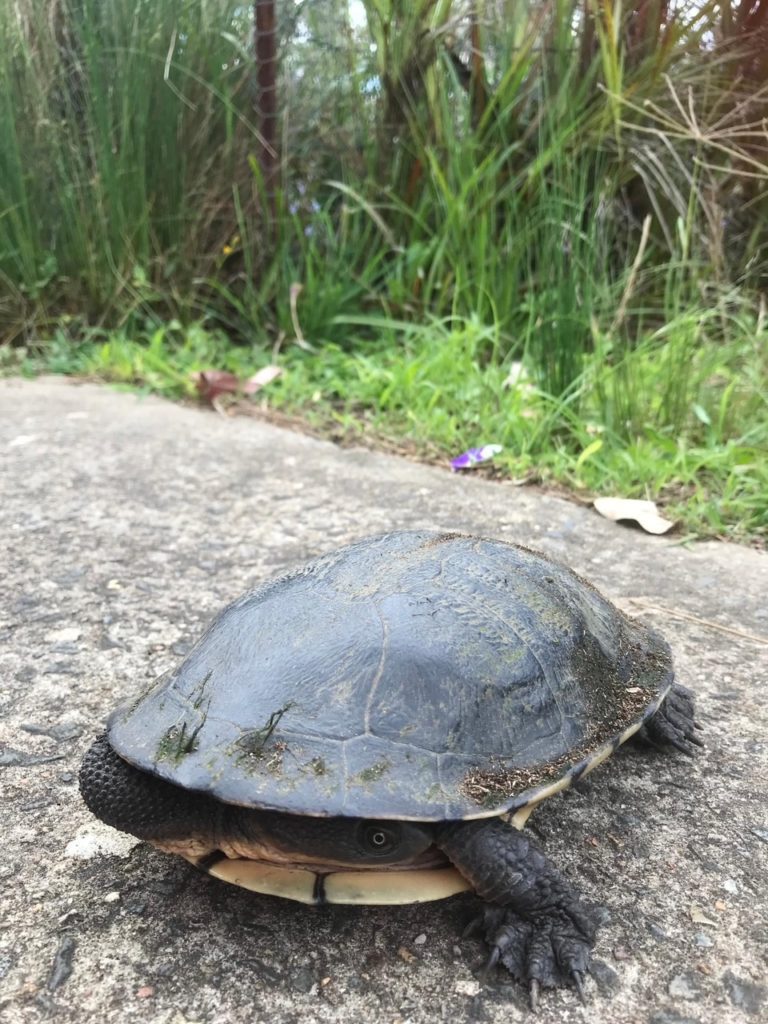Reptiles & amphibians
OVERVIEW
The Wolli Creek Valley, including the creek itself, provides a range of habitats for reptile and frog species. By looking and listening carefully and quietly, reptiles or frogs (collectively known as herpetofauna) may be found on leaf litter on the ground, basking on rocks or logs, hiding in rock crevices, beside or in the creek and in other areas where water flows or ponds.
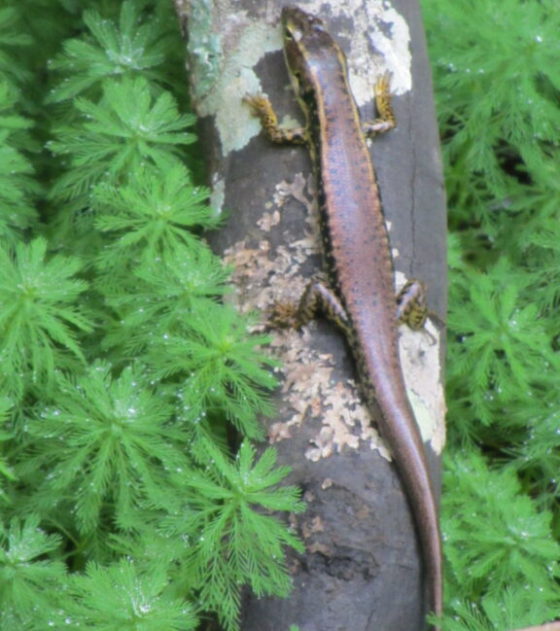
REPTILES
Few systematic surveys of the reptiles of the Wolli Creek bushland and Regional Park have been undertaken. However, over time, WCPS members and others have observed the presence of a number of species of reptiles. WCPS would welcome additional information from research scientists and their students.
Some of the reptiles observed in the Valley include:
- Copper-tailed skink
- Barred-sided skink
- Eastern blue-tongue lizard
- Eastern water dragon
- Eastern water skink
- Red-bellied black snake
- Leaf-tailed Gecko
- Eastern snake-necked turtle
Copper-tailed Skink
The Copper-tailed Skink (Ctenotus taeniolatus) is a common Sydney species. Growing to about 20cm in length, sandstone outcrops in the Wolli Valley offer it favourable hiding places.
Barred-sided Skink
The Barred-sided Skink (Eulamprus tenuis tenius) is less common. Smaller than many other species, it only grows to 16cm, and lives mostly in wet habitats such as rainforests and wet sclerophyll forests.
Eastern Blue-tongue Lizard
Also called the Eastern Blue-tongued Skink, the Eastern Blue-tongue Lizard (Tiliqua scincoides scincoides) is one of Australia’s favourite reptiles. It is the largest skink found in Australia. Eastern Blue-tongue Lizards can still be found in urban backyards where there is cover and other suitable habitat, as well as urban bushland.
Eastern Water Dragon
Found on the east coast, the Eastern water dragon (Intellagama lesueurii) is around 80cm long, and ranges in colour from dark to light brown, sometimes with darker bands. It has a distinctive dark band running horizontally from the eye, extending down the neck. Its habitat preference is for areas with flowing water, good tree cover and suitable basking sites.
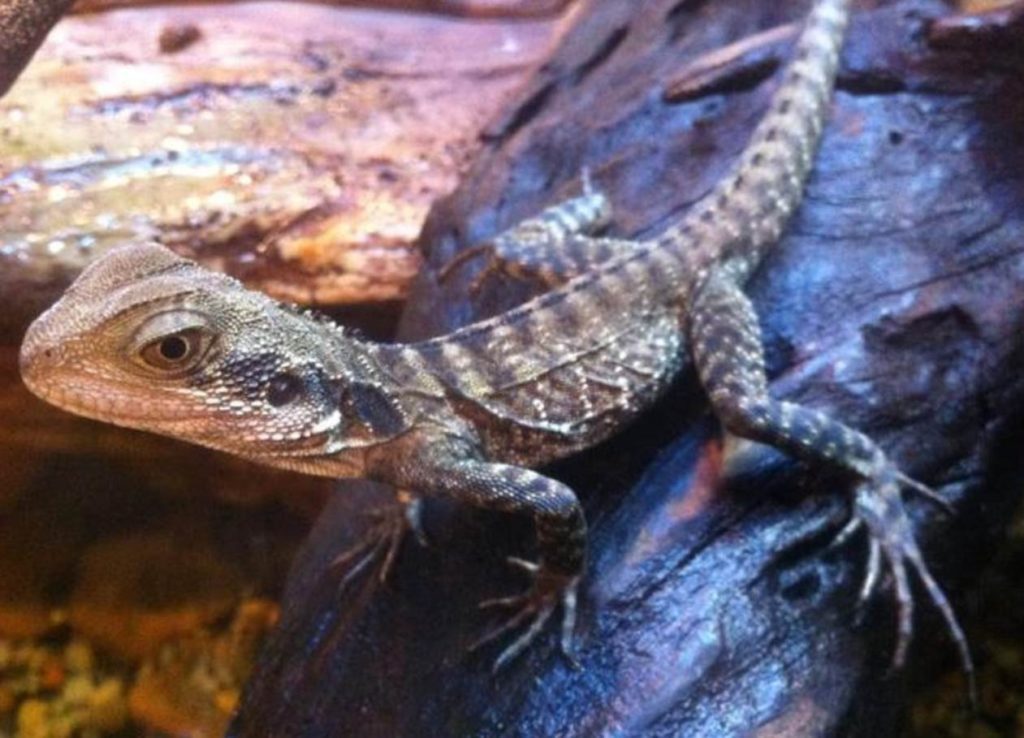
Eastern Water Skink
The Eastern Water Skink (Eulamprus quoyii) frequents streams and creeks in Sydney’s bushland. Commonly seen by bushwalkers, particularly around rocky creek lines, it grows to about 25cm long.
Red-Bellied Black Snake
The Red-bellied black snake (Pseudechis porphyriacus) is one of the most common snakes found in the Sydney region. Red-bellied black snakes are occasionally seen in the bushland along the TVT bush track. Wolli Creek and its side streams are areas they may frequent in the hunt for frogs, their favourite prey. During the mating season they may travel further afield.
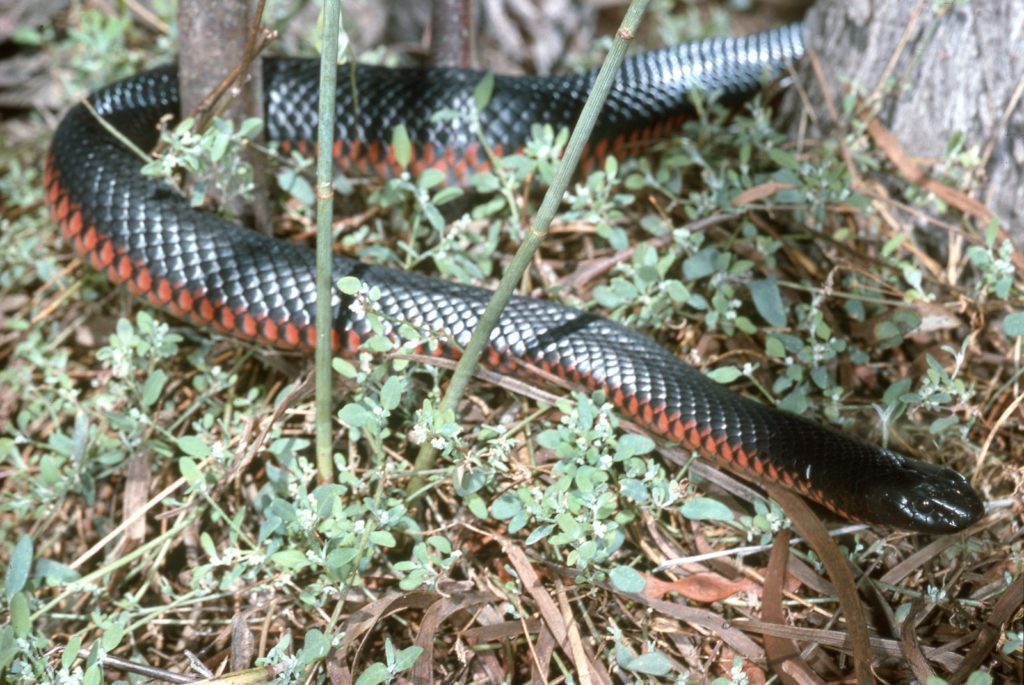
Red-bellied black snake are venomous, but they are also quite shy and retreat rather than bite. Nonetheless, any snake surprised may act defensively, so make sure dogs are on leashes and children kept close by.
For a description of the mating behaviour of the Red-bellied black snake, based on observations made around Nannygoat Hill, see “Mating Behaviour of Red Bellied Black Snakes” by P. R. Rankin in Herpetofauna Vol. 8 No. 1 Feb. 1976, pp 10-15 here (pdf) This paper by a local resident, the late Peter Rankin, provided the first scientific description of the mating behaviour of the Red-bellied black snake
Southern Leaf-tailed Gecko
The Southern Leaf-tailed Gecko (Phyllurus platurus) isn’t often seen in the Valley. The rough, scaly skin, which has a mottled grey/brown pattern, blends easily with its sandstone habitat. It shelters during the day in crevices or under rocks and rock overhangs, and feeds at night. Sometimes they are found on the brick or sandstone walls of neighbouring houses and garages.
Eastern Snake-necked Turtle
The Eastern Snake-Necked Turtle (Chelodina longicollis), also known as the Eastern Long-necked Turtle is our most common freshwater turtle. Eastern Snake-Necked Turtles need a fresh water environment, where they can find tadpoles, small fish and aquatic invertebrates to eat.
The shell of the Eastern Snake-Necked Turtle grows to 25-30cm long. Shell colours vary from fawn to dark brown or black. The hatchling shells are about 3cm long and usually black with orange markings. Eggs are laid in spring/summer (especially after rain) into holes dug into sand or other soft ground, along creek or stream banks, or other areas nor far from the water. Unfortunately, predation on their eggs by foxes and even Ravens is often observed in some areas of the Valley.
Further information
Fauna of the Wolli Valley in Inner south-west Sydney (pdf)
Australian Museum: reptiles page
NSW Department of Planning and Environment: reptiles in Sydney page
There are also a number of field guides and other books available about reptiles in the Sydney, and wider regions.
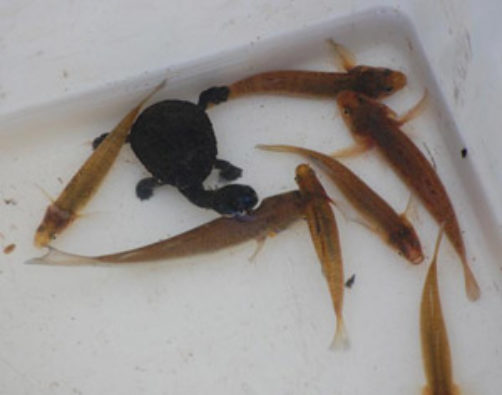
FROGS (AMPHIBIANS)
Few systematic surveys of the amphibians of the Wolli Creek bushland and Regional Park have been undertaken. However, over time, WCPS members and others have observed the presence of a number of species of frogs. WCPS would welcome additional information from research scientists and their students.
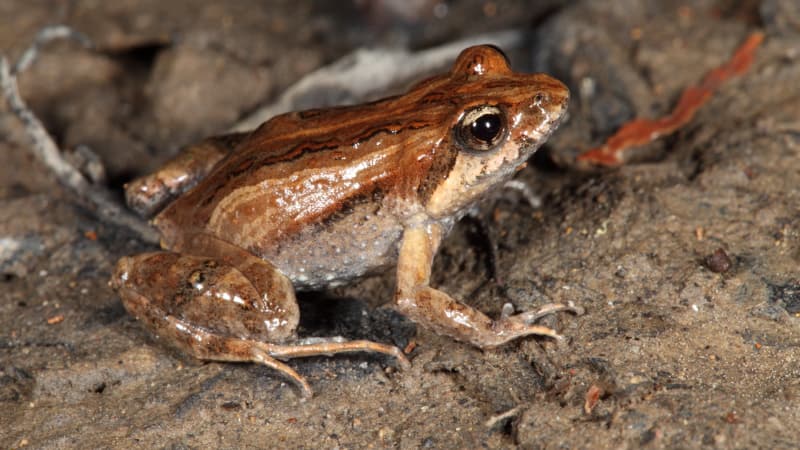
You are more likely to hear, rather than see any of the five species of frog that have been identified* in the Valley:
- Common Eastern Froglet
- Striped Marsh Frog
- Peron’s Tree Frog
- Eastern Dwarf Tree Frog
- Green Tree Frog
*initially identified by DECC survey (2007), and presence confirmed – except for Green Tree Frog – spring 2022
Common Eastern Froglet
The Common Eastern Froglet (Crinia signifera) is a small frog ranging from just under 2cm to 3cm in length, and has quite variable colouring. It is fairly common in the Valley, and other urban places. In fact it’s the most common and widespread frog in SE Australia. It breeds in a variety of water bodies, (often ditches beside railway lines!) and at any time of the year. Its call – ‘crick crick crick crick crick’ – accordingly, can usually be heard throughout the year, day or night. It sounds somewhat like the call of crickets.
Striped Marsh Frog
The Striped Marsh Frog (Lymnodynastes peronii) at around 7.5cm, is not only one of the larger frogs to be found in the Valley, but also one of the more common. It is also one of the frogs that many backyard ponds support.
The ‘bock bock bock’ call of the male, usually during the breeding season (spring to summer) sounds a bit like a tennis match, making this species one of the easier frogs to identify.
Peron’s Tree Frog
The Peron’s Tree Frog (Litoria peronii) is a larger species of frog at around 7cm in length. It may be a range of different colours depending on the environment in which it is found, and breeds from spring through to summer, after rain. It has a loud, memorable call – one description is that of a jackhammer crossed with a machine gun! It’s a not uncommon resident in suburban areas.
Eastern Dwarf Tree Frog
The Eastern Dwarf Tree Frog (Litoria fallax), is small at up to 2.5cm long. It has a bright green or bronze back and legs, and white belly. It breeds at any time of the year.
Green Tree Frog
The Green Tree frog (Litoria caerulea) at around 10-11cm long is one of the largest, and most well-spread frogs found in Australia. It has a white or yellowish belly, and may have a lime-green or an olive-yellow back – sometimes dotted with several small white spots. Well known for emerging on hot days, after rain their loud ‘werk werk werk werk’ call can be heard from within cool moist spots such as house drainpipes, tanks, pools, even toilets, especially during mating time in spring and summer. WCPS would welcome information concerning sightings or calling heard in the Valley.
Further info
Fauna of the Wolli Valley in Inner south-west Sydney (pdf)
Australian Museum frogs page and Frod ID site
NSW Department of Planning and Environment: frogs in Sydney page
There are also a number of field guides and other books available about amphibians in the Sydney, and wider regions.
